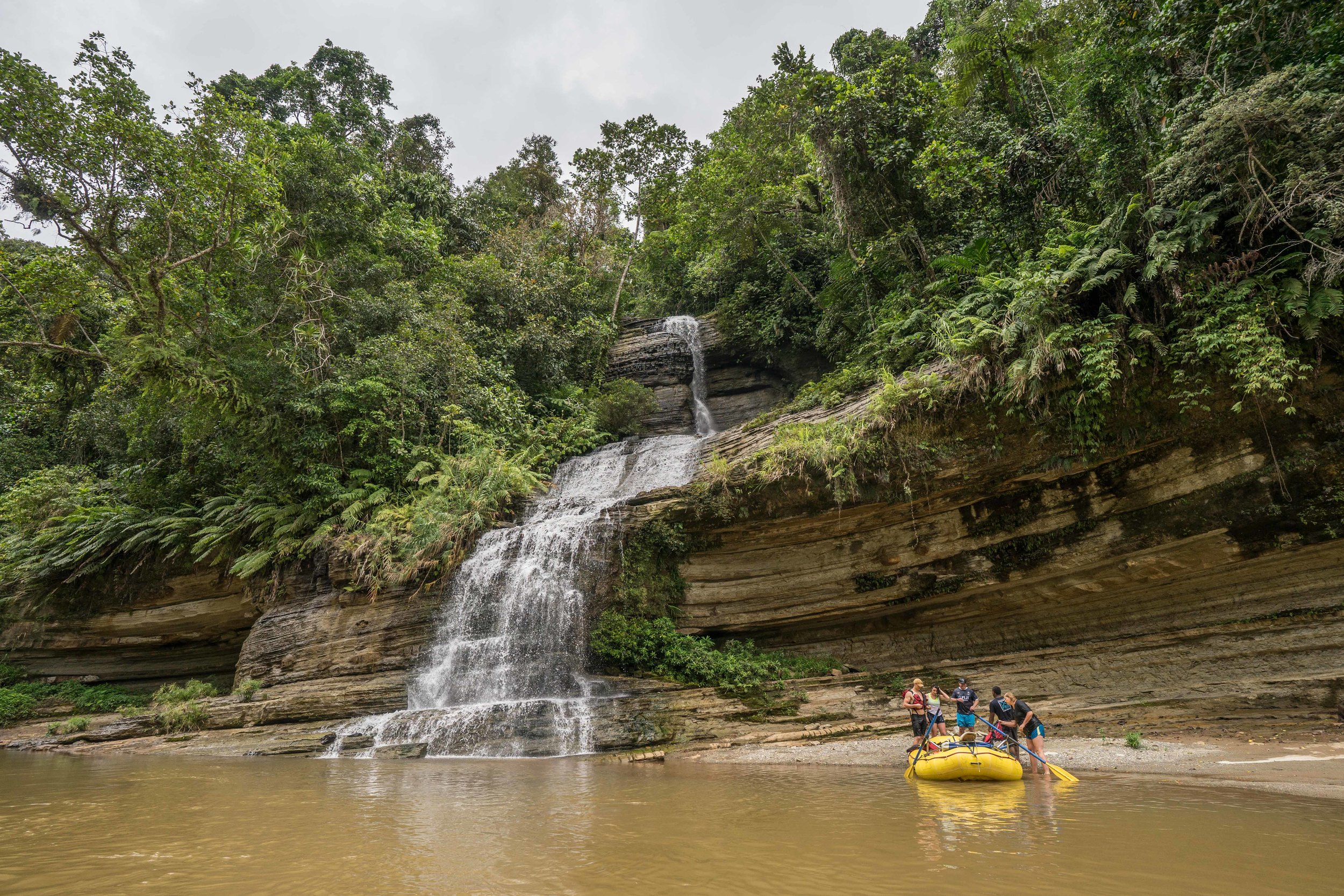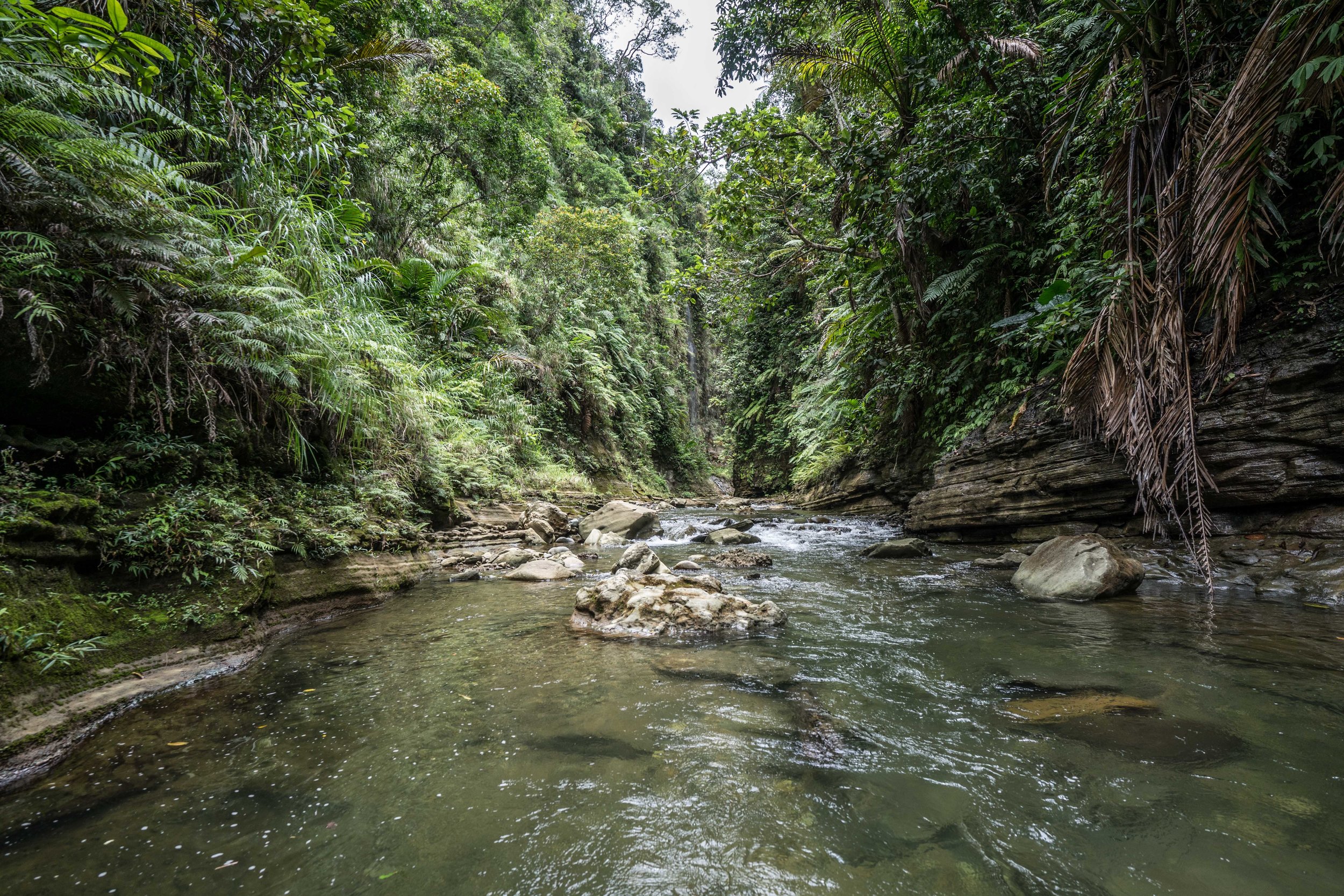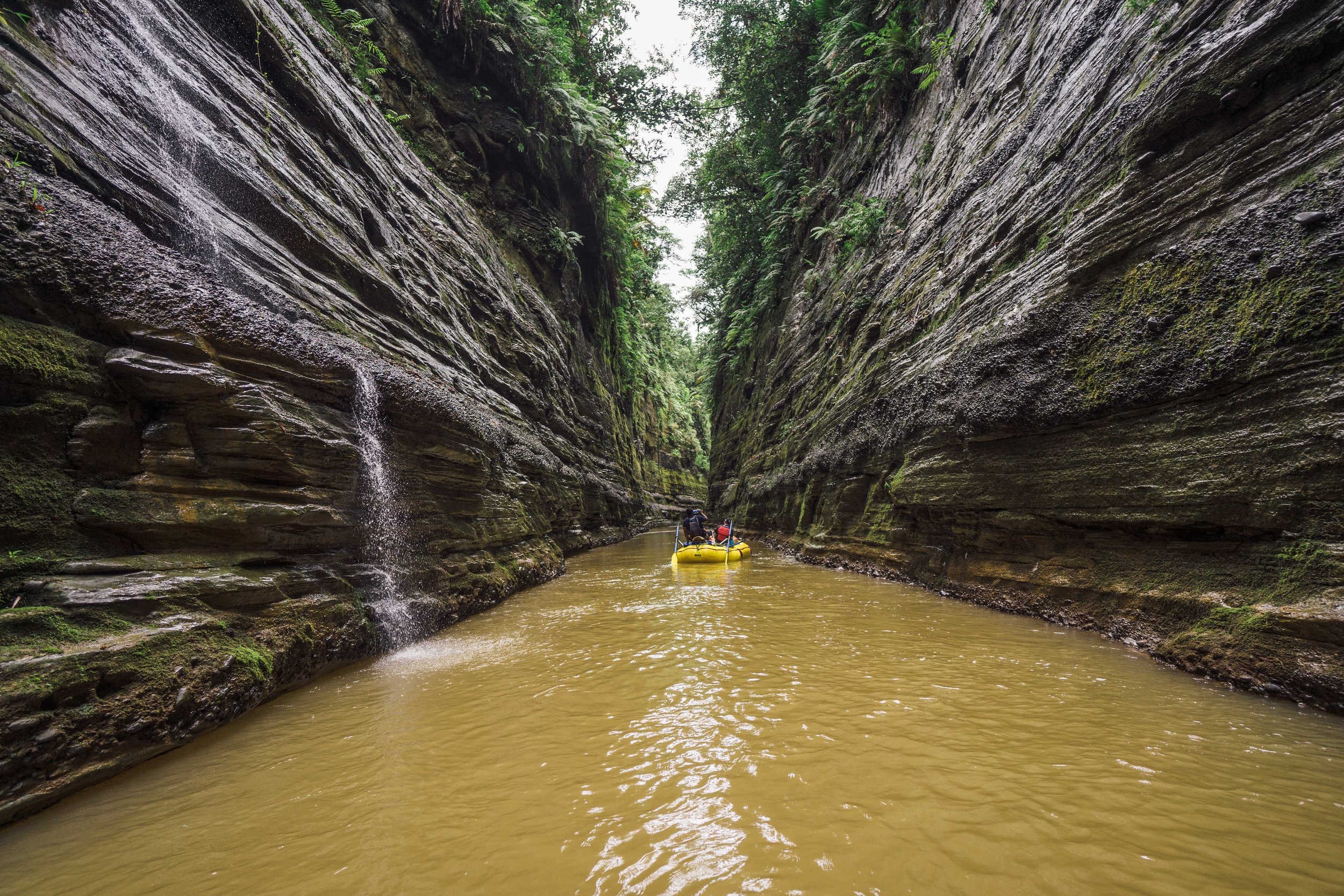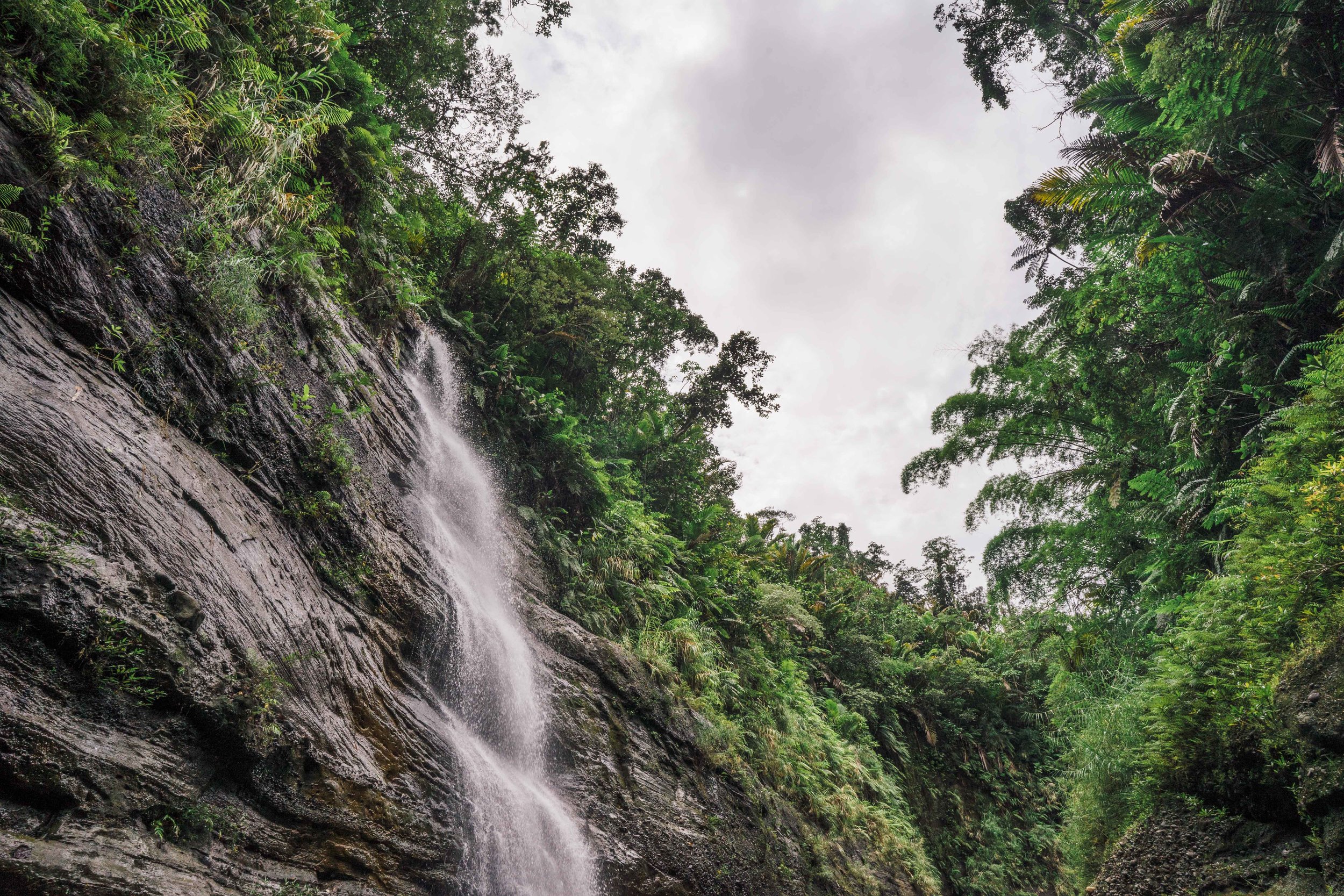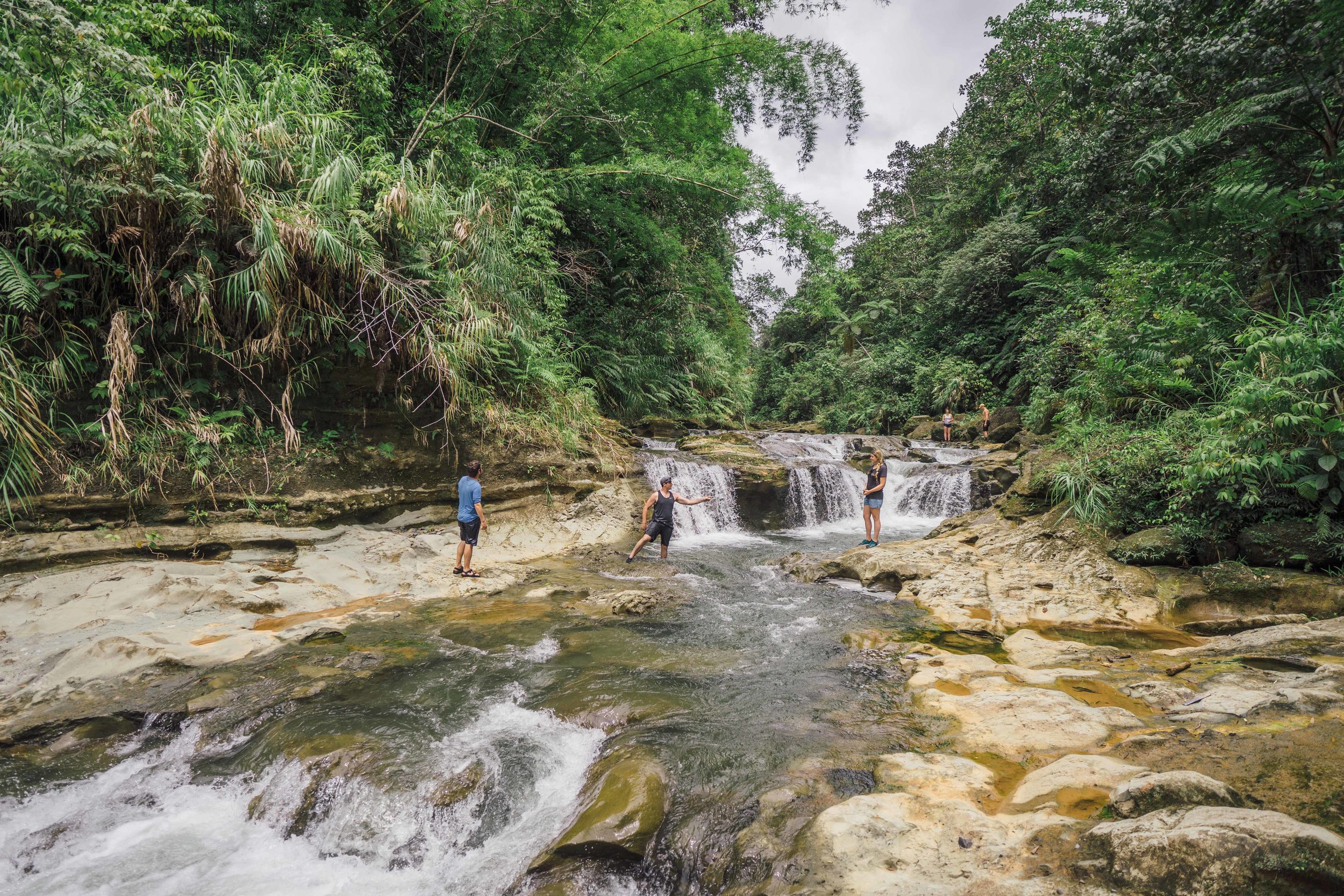FIJI’S INLAND PARADISE: River Rafting & Conservation
Text & Photos: Andreea Lotak · 8 min read
One of the stops along the Navua River during our rafting trip
Away from the coast of Fiji’s main island, Viti Levu, the lush mountains rise abruptly. The sight of the green, dense canopy of trees that covers them takes the mind to a mythical landscape of the South Pacific rainforest, where ceaseless rain swells up the rivers and waterfalls. Although the attraction of the coast, with its laid back vibe and numerous resorts, is what brings most people to Fiji, the heart of Viti Levu beats in the high mountains at its center.
Most island nations in the South Pacific have dedicated considerable effort into protecting their seas and creating marine sanctuaries, national parks and reserves. Fiji is no exception, and an interesting scuba diving project which led to the designation of the country’s first marine national park is what drove us there in the first place. However, once we arrived, our eyes also turned inland to the tall mountains and made us wonder what was up there. Locals are starting to realize that there is economic and conservation potential in creating trails and bringing hikers to the mountains, where communities have turned mostly toward logging to make a living. However, it was a rafting company that pioneered Fiji’s first land and community-based conservation project.
We met Kasi Taukeinikoro, the Managing Director of Rivers Fiji, at their headquarters in Pacific Harbour. We don’t think we’ve ever been to any place in the world where locals are more welcoming and warm-hearted than in Fiji, and the staff at the office in Pacific Harbour was no exception. Kasi had agreed to sit down with us and tell us more about the conservation work of his company, before we would go down the Upper Navua River the following morning. He began with the story of Nate and Kelly Bricker, the founders of Rivers Fiji, who came from the US in the 90s to take a trip down the river and assess its potential for bringing visitors there for rafting trips. During their first expeditions they soon realized that much of Fiji’s native forest was being replaced by mahogany plantations and that the tall, green banks of the Navua River where they were planning to organize rafting expeditions would eventually be lined with mahogany trees brought here mostly from South America. Their wild beauty would forever be altered, and the integrity of the land ecosystem would affect the river itself. That's why the idea of creating a sanctuary for native species along the river banks became central to this endeavor. For Rivers Fiji, this was also an opportunity to find ways of giving back to local communities, while getting involved in pioneering conservation work.
Upper navua conservation area
The rainforest inland is lush and beautiful, with rivers and waterfalls that carve gorges in the mountains. Taking at least a day off from the beach and heading inland promises plenty of beautiful sights and adventures.
As Kasi explained, the concept of land conservation was not common for Fiji. The designation of tabu areas, temporary no-take zones in the sea surrounding the islands, had had a long tradition here, but not land conservation areas. Historic land ownership in Fiji is based on a structure of family clans, known as mataqalis, whose decision of what happens with the piece of land they own is what decides the fate of the forest ecosystem. Logging companies have long worked with the mataqalis to obtain the rights to replace the forest with mahogany plantations, while giving them financial compensation. If Rivers Fiji was going to save a patch of the native forest along the river, it was going to be through a partnership with local mataqalis. In the year 2000, they succeeded in creating Fiji’s first public-private agreement to create the Upper Navua Conservation Area (UNCA), covering 615 ha/1500 acres and protecting a patch of native forest along the Upper Navua River. Collaboration with of a private logging company and a Fijian land trust was involved as well. Then Rivers Fiji worked to have the UNCA designated as a RAMSAR site or “Wetland of International Importance” in 2007, Fiji’s only such designation. The road to get there with the community was a long and winding one, but it was successfully navigated.
“When we went to the land owners initially, they saw it as an opportunity to make more money. But their main source of income was through logging, because they have a large forest area up there and they make deals with loggers. When it came down to our conservation lease, they were more reticent because we wouldn’t be able to offer them as much as the logging companies who could afford to buy them 4WD vehicles. So we knew we had to work to get this from within, to show locals what they can learn about this conservation area. We wanted them to fall in love with it, to genuinely see what we’re protecting. We felt that the elders were very hard to convince back then, so we went to all the schools in the area where we knew the land owners were sending their kids. We went there and talked about conservation. When the UNCA was declared a RAMSAR site in 2007 we started celebrating RAMSAR Day with them. We did drawings and essay writing contests. It was about 19 years ago that all of this started. Some of those children are adults. Now it’s always good to go to the meetings in the villages, because a lot of them speak our language. You know? They talk about conservation. We have seven more years on the old lease which was given for 25 years in 2000, and we have to discuss renewal. I have already gone these past weeks to all the land owners. Now everyone fully understands what’s in the lease for them, what it means. It’s much easier, everyone talks about the same things and we’re working to get the next lease for 99 years. We've started taking locals from the villages down the river, we take them to show them its beauty. We take all the school children and teachers to show them what’s so important for them to protect”, Kasi tells us.
Navua River Gorge
At the beginning of the rafting trip, we travel through the narrow gorge of the Upper Navua River. This is a stunning, peaceful landscape right before we got into a long succession of class II and III rapids.
The 24 staff members and river guides at Rivers Fiji come from the villages of the nine mataqalis that leased them the rights to the conservation land use. The families also receive financial compensation for each tourist that goes down the Upper Navua River, and the company brings over doctors for regular check-ups, as well as biologists from organizations that can better assess the biodiversity of the river and forests around it. “Most of the birds and reptiles we see there are endemic to Fiji, some to the area itself. We’ve seen lots of birds, iguanas, and snakes. We’re seeing that the conservation area is working well, somehow the wildlife knows that this is safe for them to congregate”, Kasi says with a smile. Since the designation was established in 2000, a new species of fish was discovered in the river: the orange spotted scaleless goby. In order to protect this wild treasure, the company has a strong Leave No Trace ethic while out on the river, where nothing is altered or left behind and where the guides take responsibility to minimize our impact as visitors.
During our trip down the river we were lucky to have Moses Batirua as our guide. He is one of the first guides trained by the company, and his pride for what he calls his "office" is inspiring. He told us how at first, when Nate came to his village to recruit potential rafting guides in 1998, Moses doubted himself. Many of the young men were reluctant to jump at the opportunity, but did eventually. Now he says he will never regret accepting the training and becoming a rafting guide, as he gets to share the beauty of his home on the Upper Navua River with people from around the world. And the gorge through which the raft flows down, rapid after rapid, is breathtaking. While the rapids can be powerful when there is substantial rainfall, it’s mostly class II and III rapids otherwise, but their fast succession makes it for an exciting ride even for people who are not doing rafting for the first time. This is a truly beautiful full-day trip, whose added bonus is that it contributes to conserving a patch of native forest that is teeming with life. While floating we saw Flying foxes, white collared kingfishers, Pacific black ducks and heard the calls of many different bird species. This is an initiative that connects conservation, the outdoors, local communities, and biodiversity into one thrilling float down the stunning Upper Navua.
Waterfalls and dense native vegetation are common sights along the rafting section of the Upper Navua River.
Exploring one of the side rivers with natural swimming pools while lunch by the Navua River was being set up by our guides.
Moses takes the group for a free "massage" under one of the waterfalls toward the end of the trip.

